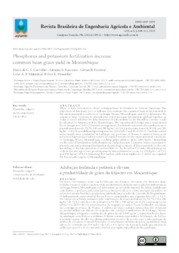Phosphorus and potassium fertilization increase common bean grain yield in Mozambique.
Phosphorus and potassium fertilization increase common bean grain yield in Mozambique.
Autoria: CARVALHO, M. da C. S.; NASCENTE, A. S.; FERREIRA, G. B.; MUTADIUA, C. A. P.; DENARDIN, J. E.
Resumo: There is little information about common bean fertilization in African Savannas. The objectives of this study were as follows: i) to evaluate the common bean yield potential in the environmental conditions of Lichinga, Niassa, Mozambique, and ii) to determine the common bean response to phosphorus and potassium fertilization applied together in order to verify whether the interpretation of soil analysis for the Brazilian Cerrado could be adopted for Savanna soils in Mozambique. The experimental design was a randomized block design in a 5 x 4 x 2 factorial arrangement. Treatments consisted of a combination of phosphorus doses (0, 35, 70, 140 and 280 kg ha-1 of P2O5), potassium doses (0, 50 100 and 200 kg ha-1 of K2O), and different growing seasons (2012/2013 and 2013/2014). The field rainfed experiments were conducted in Lichinga city, province of Niassa. Common bean crops presented high productivity potential in rainfed systems in the environmental conditions of Lichinga, Niassa, Mozambique, reaching grain yields of up to 3,600 kg ha-1 depending on the rates of fertilization with phosphorus and potassium. Common beans responded to phosphorus and potassium fertilization despite high contents of these nutrients in the soil, according to the interpretation of soil analysis for the Brazilian Cerrado. Maximum grain yield in the average of two growing seasons was estimated to occur for 239 kg ha-1 of P2O5 and 141 kg ha-1 of K2O, indicating that further calibration studies for P and K are required for this specific region of Mozambique.
Ano de publicação: 2018
Tipo de publicação: Artigo de periódico
Unidade: Embrapa Arroz e Feijão
Observações
1 - Por padrão são exibidas publicações dos últimos 20 anos. Para encontrar publicações mais antigas, configure o filtro ano de publicação, colocando o ano a partir do qual você deseja encontrar publicações. O filtro está na coluna da esquerda na busca acima.
2 - Para ler algumas publicações da Embrapa (apenas as que estão em formato ePub), é necessário ter, no celular ou computador, um desses softwares gratuitos. Sistemas Android: Google Play Livros; IOS: iBooks; Windows e Linux: software Calibre.
Acesse outras publicações
Acesse a Base de Dados da Pesquisa Agropecuária (BDPA) para consultar o acervo completo das bibliotecas da Embrapa.

